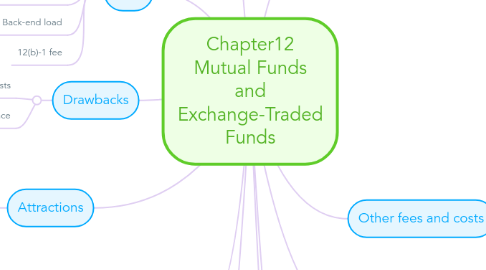
1. Factors in Comparing Mutual Funds
1.1. Fund's investment performance
1.2. Tax efficiency
1.3. Fee structure
1.4. How particular fund fits into your profolio
1.5. Investment skills of fund managers
1.6. Load or No-load funds
1.7. Closed End or open-end funds
2. The management Company
2.1. Open-end investment companies
2.1.1. Investors buy and sell shares directly without a secondary market
2.1.2. Fund can issue an unlimited number of shares
2.2. Closed end investment companies
2.2.1. sell shares in the fund only at the initial offering
2.2.2. doesn't have to worry about cash inflow or outflows
2.2.3. market price of fund's shares is determined by supply and demand.
2.2.4. have a limited numbers of shares
2.3. Exchange-traded funds(ETF)
2.3.1. Similar to index mutual funds
2.3.2. Trade like individual stocks on stock exchanges
2.3.3. Low turnover
2.3.4. Low management expenses
2.4. Unit Investment trusts(UIT)
2.4.1. Have shares that represent a proportionate shares of trust
2.4.2. fixed pool of securities,normally bonds
2.4.3. not actively managed;securuties in portfolio remain static
2.5. Real Estate investment trusts(REIT)
2.5.1. Provide high devidends along with capital apprciation potential
2.5.2. Closed-end investment company that invests in mortgages and various types of real estate investments
2.6. Hedge funds
2.6.1. Private limited patnerships
2.6.2. not regulated by mutual fund regulations
2.6.3. Only sold to "accredited investors"
3. Fees
3.1. Load fund
3.2. No-load fund
3.3. Low-load fund
3.4. Back-end load
3.5. 12(b)-1 fee
4. Drawbacks
4.1. Substantial transaction costs
4.2. Lower-than-market performance
5. Attractions
5.1. Portfolio diversification
5.2. Service
5.3. Convenience
5.4. Ability to invest small amounts
5.5. professional management
6. Definition
6.1. Mutual Fund:an investment company that invests its shareholders'money in a diversified portfolio of securuties
7. Types of Mutual Funds
7.1. Growth Fund
7.1.1. Primary goals are capital gains and long-term growth
7.2. Aggressive Growth Fund
7.2.1. Highly speculative mutual fund that seeks large profits from capital gains
7.3. Value Fund
7.3.1. seeks stocks that are undervalued in the market
7.4. Equity-Income Fund
7.4.1. Emphasizes current income and capital preservation
7.5. Balanced Fund
7.5.1. Generates a balanced return of both current income and long term capital gains
7.6. Growth-and-Income Fund
7.6.1. Seeks both long-term growth and current income
7.7. Bond Funds
7.7.1. Invests in variuos kinds and grades of bonds
7.8. Money Market Fund
7.8.1. Invest in short-term securities
7.9. Index Funds
7.9.1. Buys and holds a portfolio of stocks(or bond)
7.10. Sector Funds
7.10.1. Investments are resticted to a particular segment of the market
7.11. Socially Responsible Funds
7.11.1. Funds that actively and directly incorporate ethics and morality into the investment decision
7.12. Asset Allocation Funds
7.12.1. Funs that spread investors'money across stocks,bond,and monet market securities
7.13. International Funds
7.13.1. Funds that do all or most of their investing in foreign securities.
8. Selecting Mutual Funds
8.1. Determine if you want to use mutual funds in portfolio
8.2. Mutual Fund Investor Services
8.2.1. Automatic Investment Plans
8.2.2. Automatic Reinvestment of Interest,dividend,and capital gains
8.2.3. Systematic withdrawal plans
8.2.4. Conversion(exchange)privileges
8.2.5. Phone switching
8.2.6. Easy establishment of retirement plans
